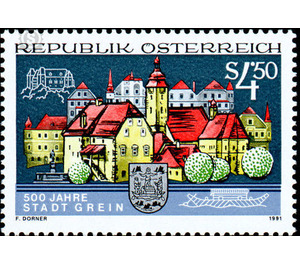500 years - Austria / II. Republic of Austria 1991 - 4.50 Shilling
Theme: Architecture
| Country | Austria / II. Republic of Austria |
| Issue Date | 1991 |
| Face Value | 4.50 |
| Color | multi-colored blue |
| Printing Type | Photogravure |
| Stamp Type | Commemorative |
| Item Type | Stamp |
| Chronological Issue Number | 1373 |
| Chronological Chapter | OOS-OE2 |
| Michel ID | OOS 2030 |
| SID | 141764 |
| In 64 Wishlists | |
Grein is located in a small bay at the entrance of the Strudengau on the Danube. Special importance for the origin of the place had the Danube navigation. The town was first mentioned in 1147 and 1215 raised to the market. During the 13th, 14th and 15th centuries, the Greiner citizens were granted numerous privileges and freedom of trade by their sovereign. This Grein was always wealthy and 1491 by Emperor Frederick III. raised to the city. From the 15th to the middle of the 18th century, the city experienced its heyday until it was deprived of privileges and trade freedoms in the stormy year of 1848. In addition, the main traffic routes shifted from the Danube region into the Alpine foothills. That is why tourism was started, which continues to be the economic pillar of this picturesque city on the Danube.
| Condition | Name | In Stock | Price | Price + Shipping | Store | |
|---|---|---|---|---|---|---|
 | Unmounted Mint ** | 500 years - Austria / II. Republic of Austria 1991 - 4.50 Shilling | 1 | US $0.535 | US $3.73 |  FILATELIELOKET (0) FILATELIELOKET (0)Shipping US $3.20 Minimum Order US $2.67 |


